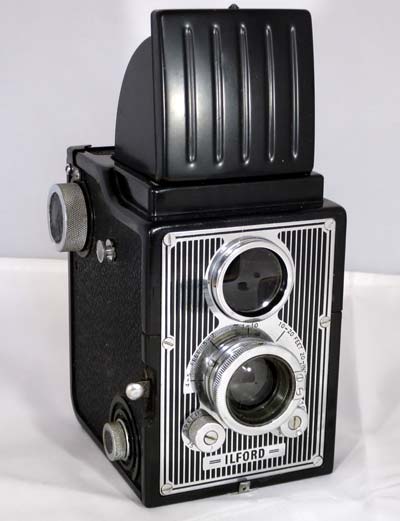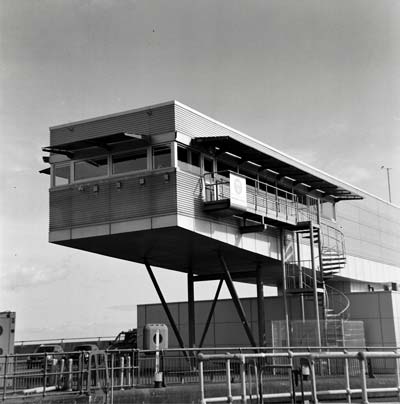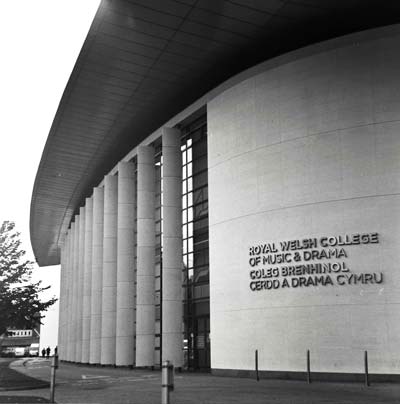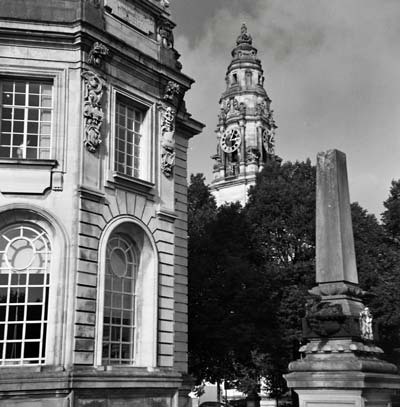Ilford Craftsman
Specification

| Manufacturer | : | Ilford |
|---|---|---|
| Produced | : | 1949 |
| Classification | : | Medium Format |
| Body Type | : | Pseudo Twin Lens Reflex |
| Construction | : | Bakelite/Metal |
| Film Type | : | 120 or 620 |
| Film Width | : | 62mm |
| Image Size | : | 2¼ x2 ¼ in |
| No. of Images | : | 12 |
| Lens Type | : | Ilford |
| Focal Length | : | 95mm |
| Focus Type | : | Variable |
| Focus Range | : | 4ft to inf |
| Aperture Type | : | Multihole |
| Aperture | : | f/9, f/18 |
| Shutter Type | : | Everset |
| Shutter Speeds | : | B,I(1/25, 1/75 sec) |
| Size (w x h x d) | : | 88 x 110 x 98 mm |
| Size - hood up (w x h x d) | : | 88 x 167 x 98 mm |
| Weight | : | 620g |
Art Deco Credentials
![]()
![]()
![]()
Noteworthy: Worth giving special attention
- produced after the main Art Deco period
- vertical stripe to front panel
- chrome plated and enamel used for front panel.
- chrome case latch
- bright chrome detailing on viewfinder and knobs
- ribbed design on viewfinder cover
- raised concentric circles in Bakelite around knobs
- symmetrical layout to front
Description
The Craftsman can be described as a pseudo twin lens reflex camera. It isn't a true TLR because the top lens is just part of the viewfinder and does not aid focussing.
It has a leather-grain patterned Bakelite body, with a fixed focus viewing lens and screw-out focussing object lens.
The focus zones are marked 4-5, 5-7, 7-10, 10-20 and 20-infinity feet. There are two knobs on the front giving a choice of f9 and f18 for aperture and for speeds of 1/75s, 1/25s + B. There is flash synchronisation using a two-pin connector on the left side It has a metal viewfinder hood/cover and a chromed vertical-striped front panel. There is a red window with a cover operated by a knob on the lower left of the back. The Craftsman takes twelve 6x6cm images on 120 or 620 film
How to Use
Nominal shutter speeds are 1/25s or 1/75s and aperture choice is f/9 or f/18. These are awkward values for working out exposure.
If you don't want to bother with an exposure meter, follow the guide shown. It is based on the 'Sunny 16' rule. Film is so forgiving and will produce acceptable results even when overexposed by 2 or 3 stops or underexposed by 1 stop.
Remember that the exposure guide in the camera user manual may not be helpful as it is based on the use of old film with a low ISO value.
The tables assume that the sun is at least 30 degrees above the horizon - that's 10am - 5pm on a summer's day in the UK.
Where there is a choice, a larger f number will give a larger depth of field.
For the slower speeds, you may need a tripod to stop blur through shake.
Using ISO 400 film
| Weather Conditions | Shadow Detail | Shutter Speed (s) | |
|---|---|---|---|
| 1/25 | 1/75 | ||
 Sunny SunnySnow/Sand | Dark with sharp edges | - | f/18 |
 Sunny Sunny | Distinct | - | f/18 |
 Slight Overcast Slight Overcast | Soft around edges | f/18 | f/18 |
 Overcast Overcast | Barely visible | f/18 | f/18 |
 Heavy Overcast Heavy Overcast | None | f/18 | f/9 |
 Open Shade Open Shade/Sunset | None | f/18 | f/9 |
Photographs taken with this Camera
Film - Ilford Delta 400.





